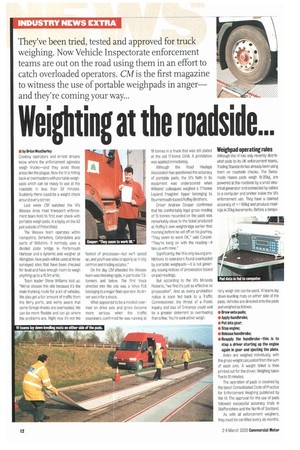Weighting at the roadside...
Page 14

If you've noticed an error in this article please click here to report it so we can fix it.
They've been tried, tested and approved for truck weighing. Now Vehicle Inspectorate enforcement teams are out on the road using them in an effort to catch overloaded operators. CM is the first magazine to witness the use of portable weighpads in anger— and they're coming your way...
• by Brian Weather* Cowboy operators and errant drivers know where the enforcement agencies weigh trucks—and they avoid those areas like the plague. Now the VI is hitting back at overloaders with portable weighpads which can be ready to use at the roadside in less than 30 minutes. Suddenly there could be a weight check around every corner.
Last week CM watched the VI's Wessex Area road transport enforcement team hold its first ever check with portable weigh pads. in a layby on the A3 just outside of Petersfield.
The Wessex team operates within Hampshire, Berkshire, Oxfordshire and parts of Wiltshire. It normally uses a divided plate bridge in Portsmouth Harbour and a dynamic axle weigher at Abingdon. Now pads will be used at three surveyed sites that have been checked for level and have enough room to weigh anything up to a 16.5m artic.
Team leader Steve Williams told us: "We've chosen this site because it's the main trunking route for a lot of vehicles. We also get a fair amount of traffic from the ferry ports, and we're aware that some foreign trucks are overloaded. We can be more flexible and can go where the problems are. Right now it's not the fastest of processes—but we'll speed up, and you'll see sites cropping up in city centres and trading estates."
On the clay CM attended the Wessex team was checking rigids, in particular 7.5tonners and below. The first truck directed into the site was a Volvo FL6 belonging to a major fleet operator. Its driver was in for a shock.
What appeared to be a modest overload on drive axle and gross became more serious when the traffic examiners confirmed he was running at 18 tonnes in a truck that was still plated at the old 17-tonne GVW. A prohibition was applied immediately.
Although the Road Haulage Association has questioned the accuracy of portable pads, the VI's faith in its equipment was underscored when Williams' colleagues weighed a 17-tonne Leyland Freighter tipper belonging to Bournemouth-based Roffey Brothers.
Driver Andrew Cooper confirmed that his comfortably legal gross reading of 15 tonnes recorded on the pads was remarkably close to the ticket produced at Roffey's own weighbridge earlier that morning before he set off on his journey. "They seem to work OK," said Cooper. "They're bang on with the reading—it ties up with mine."
Significantly, the VI is only issuing prohibitions to operators found overloaded by portable weighpads—it is not generally issuing notices of prosecution based on pad readings.
But according to the VI's Miranda Roberts, "we find it's just as effective as prosecution". And as every prohibition notice is soon fed back to a Traffic Commissioner, the threat of a Public Inquiry and loss of 0-licence could well be a greater deterrent to overloading than a fine. You're sunk either weigh. Although the VI has only recently distributed pads to its UK enforcement teams, Trading Standards has already been using them on roadside checks. The Swissmade Haenn pads weigh 15-20kg, are powered at the roadside by a small electrical generator and connected by cables to a computer and printer inside the VI's enforcement van. They have a claimed accuracy of +/-100kg and produce readings in 20kg increments. Before a tempo rary weigh site can be used, VI teams lay down levelling mats on either side of the pads. Vehicles are directed onto the pads and weighed as follows:
• Draw onto paft • Apply handbrake;
• Put htte gear, II Stop engine;
• Release handbrake; • Reapply the handbralte—this is to stop a driver starting up the engine again in gear and 4ectIng the Mate. Axles are weighed individually, with the gross weight calculated from the sum of each axle. A weight ticket is then printed out for the driver. Weighing takes five to 10 minutes.
The operation of pads is covered by the latest Consolidated Code of Practice for Enforcement Weighing published by the VI. The approval for the use of pads followed successful accuracy trials in Staffordshire and the North of Scotland.
As with all enforcement weighers, they must be certified every six months.








































































































